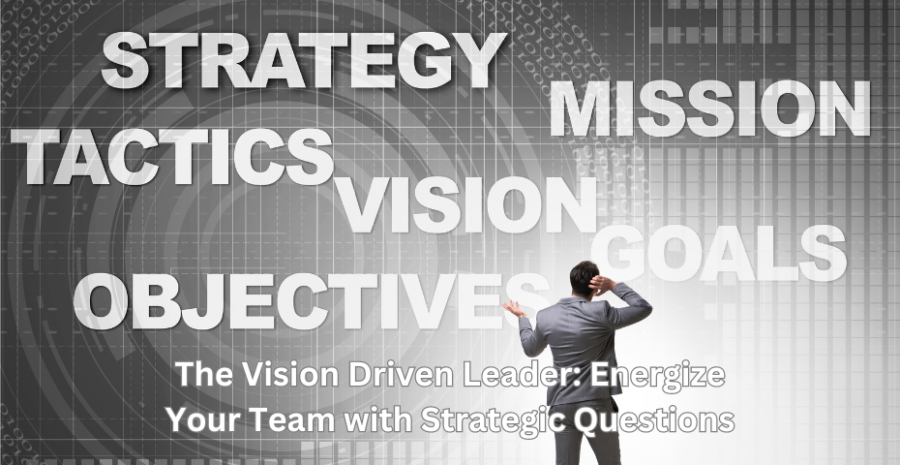The Vision Driven Leader: Energize Your Team with Strategic Questions

In today’s dynamic business landscape, visionary leadership is crucial for motivating teams and scaling operations. Vision-driven leaders inspire their teams by asking strategic questions that align efforts with the company’s goals.
In an era where innovation and adaptability are key to staying competitive, leaders who can articulate a clear vision and engage their teams in meaningful ways are more likely to succeed. This approach not only drives productivity but also fosters a sense of purpose and commitment among employees.
A vision-driven leader understands that the right questions can unlock potential, clarify direction, and build a cohesive and energized team. By consistently posing strategic questions, leaders can navigate complexities, overcome challenges, and seize opportunities.
This process encourages a culture of continuous improvement and resilience, where every team member feels valued and motivated to contribute to the company’s success. Here are ten pivotal questions to help you energize your team and drive your business forward.
Through these questions, you can create a roadmap that aligns daily efforts with long-term objectives, ensuring that your team remains focused, engaged, and prepared to scale new heights.
Here are ten pivotal questions to help you energize your team and drive your business forward.
1. What is our ultimate goal?

Clarifying the ultimate goal of your organization is essential for maintaining focus and direction. As a vision-driven leader, you must ensure that everyone on your team understands the long-term objectives. This clarity not only fosters a sense of purpose but also aligns individual efforts with the collective mission.
Regularly revisiting and communicating these goals can keep the team motivated and committed. By asking, “What is our ultimate goal?” you set a clear target that guides decision-making and prioritization. This question helps prevent distractions and keeps everyone working towards a common vision.
2. How can we align our daily tasks with our vision?

Daily tasks can often become routine and disconnected from the broader vision. To avoid this, it's crucial to continuously align day-to-day activities with the overarching goals. By asking how daily tasks contribute to the vision, leaders can ensure that every action taken by the team moves the organization closer to its ultimate goal.
This alignment boosts productivity and morale, as employees see the direct impact of their work. Regular check-ins and discussions about task alignment can foster a culture of purpose and intentionality within the team.
3. What are our core values and how do they shape our actions?

Core values are the foundation of a company’s culture and decision-making processes. They guide behaviors, shape interactions, and influence strategic choices. By asking about the core values, leaders can reinforce the principles that define the organization.
Discussing how these values shape actions ensures that the team remains true to its identity, even as it scales. This consistency builds trust among employees and with external stakeholders. Regularly reflecting on core values helps maintain a cohesive and value-driven approach to business operations.
4. What strengths can we leverage to achieve our vision?

Every team has unique strengths that can be harnessed to achieve the company’s vision. Identifying and leveraging these strengths can accelerate progress and create a competitive advantage. By asking this question, leaders can uncover hidden talents and capabilities within their team.
This not only maximizes the team’s potential but also boosts confidence and engagement. Recognizing and utilizing strengths encourages a strengths-based culture, where employees are empowered to excel in areas where they naturally thrive. This approach leads to higher performance and job satisfaction.
5. What challenges are we facing and how can we overcome them?
.png)
Challenges are inevitable in any business journey, ranging from market competition to internal inefficiencies. Addressing them head-on is crucial for maintaining momentum and morale. By asking about the challenges, leaders can identify obstacles early and develop strategies to overcome them.
This proactive approach prevents small issues from escalating into major problems. It also fosters a culture of resilience and adaptability, empowering teams to tackle difficulties with a solution-oriented mindset. Encouraging open discussions about challenges allows the team to collaboratively brainstorm solutions, leading to more innovative and effective outcomes.
Additionally, recognizing and addressing challenges transparently builds trust and shows that leadership is committed to overcoming hurdles together. This shared problem-solving effort not only strengthens team cohesion but also ensures that the organization remains agile and prepared for future challenges.
Regularly revisiting and reassessing these challenges can help the team stay ahead of potential issues, continuously improving and evolving. By confronting challenges directly and collaboratively, vision-driven leaders can turn potential setbacks into opportunities for growth and learning.
6. How can we foster a culture of continuous improvement?

A culture of continuous improvement is vital for long-term success. It involves regularly assessing processes, seeking feedback, and making incremental changes. By asking how to foster this culture, leaders can encourage a mindset of constant growth and innovation.
This approach ensures that the team remains agile and responsive to changing market conditions. Continuous improvement also enhances employee engagement, as individuals feel valued and involved in the evolution of the company. Implementing regular reviews and feedback loops can solidify this culture within the organization.
7. What opportunities for growth can we explore?

Opportunities for growth are often abundant but require strategic identification and pursuit. By asking about potential growth opportunities, leaders can inspire the team to think creatively and explore new avenues. This question encourages a forward-thinking mindset and a proactive approach to business development.
Exploring growth opportunities can involve expanding into new markets, diversifying product offerings, or forming strategic partnerships. By fostering an environment where opportunities are actively sought out, leaders can drive innovation and propel the company forward.
8. How can we enhance collaboration and communication within our team?

Effective collaboration and communication are the cornerstones of a successful team. By asking how to enhance these aspects, leaders can identify barriers and implement strategies to improve teamwork. This might involve adopting new communication tools, restructuring team dynamics, or fostering a more inclusive culture.
Improved collaboration and communication lead to better decision-making, increased efficiency, and stronger relationships within the team. Regular team-building activities and open forums for discussion can further enhance these elements, creating a more cohesive and productive work environment.
9. How can we measure and celebrate our successes?

Measuring and celebrating successes is crucial for maintaining motivation and recognizing the team’s hard work. By asking this question, leaders can establish metrics for tracking progress and milestones. Celebrating achievements, no matter how small, reinforces positive behaviors and boosts morale.
It also provides an opportunity for reflection and learning. Recognizing success fosters a sense of accomplishment and encourages continued effort towards the vision. Implementing regular recognition programs and celebrating wins as a team can create a positive and motivating work culture.
10. How can we ensure long-term sustainability and impact?

Long-term sustainability and impact should be at the forefront of any vision-driven leader’s strategy. By asking how to ensure these aspects, leaders can develop plans that balance immediate goals with future needs. This involves considering environmental, social, and economic factors in decision-making.
Ensuring sustainability and impact builds a resilient and responsible organization. It also enhances the company’s reputation and trust with stakeholders. By integrating sustainability into the core strategy, leaders can drive meaningful and lasting change.
By asking these strategic questions, vision-driven leaders can energize their teams, align efforts with the company’s goals, and scale their businesses effectively.
Each question serves as a tool to inspire action, foster collaboration, and drive continuous improvement.
(1).jpg)
About: Andries vanTonder (65)
Over 45 years selfemployed
He is a Serial Entrepreneur, an Enthusiastic supporter of Blockchain Technology and a Cryptocurrency Investor
Find me: Markethive Profile Page | My Twitter Account | My Instagram Acount | and my Facebook Profile.
Markethive News
.png)
%20(1).png)
.gif)